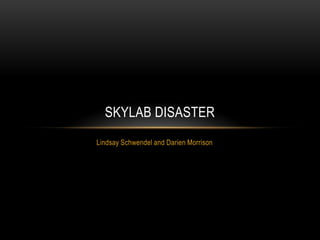Skylab
•Als PPTX, PDF herunterladen•
2 gefällt mir•1,604 views
oh kibbles
Melden
Teilen
Melden
Teilen

Empfohlen
Empfohlen
Weitere ähnliche Inhalte
Ähnlich wie Skylab
Ähnlich wie Skylab (12)
Kürzlich hochgeladen
Kürzlich hochgeladen (20)
EMPOWERMENT TECHNOLOGY GRADE 11 QUARTER 2 REVIEWER

EMPOWERMENT TECHNOLOGY GRADE 11 QUARTER 2 REVIEWER
Biography Of Angeliki Cooney | Senior Vice President Life Sciences | Albany, ...

Biography Of Angeliki Cooney | Senior Vice President Life Sciences | Albany, ...
Boost Fertility New Invention Ups Success Rates.pdf

Boost Fertility New Invention Ups Success Rates.pdf
How to Troubleshoot Apps for the Modern Connected Worker

How to Troubleshoot Apps for the Modern Connected Worker
Apidays New York 2024 - Accelerating FinTech Innovation by Vasa Krishnan, Fin...

Apidays New York 2024 - Accelerating FinTech Innovation by Vasa Krishnan, Fin...
Apidays New York 2024 - Passkeys: Developing APIs to enable passwordless auth...

Apidays New York 2024 - Passkeys: Developing APIs to enable passwordless auth...
Apidays New York 2024 - Scaling API-first by Ian Reasor and Radu Cotescu, Adobe

Apidays New York 2024 - Scaling API-first by Ian Reasor and Radu Cotescu, Adobe
TrustArc Webinar - Unlock the Power of AI-Driven Data Discovery

TrustArc Webinar - Unlock the Power of AI-Driven Data Discovery
Introduction to Multilingual Retrieval Augmented Generation (RAG)

Introduction to Multilingual Retrieval Augmented Generation (RAG)
"I see eyes in my soup": How Delivery Hero implemented the safety system for ...

"I see eyes in my soup": How Delivery Hero implemented the safety system for ...
Finding Java's Hidden Performance Traps @ DevoxxUK 2024

Finding Java's Hidden Performance Traps @ DevoxxUK 2024
Modular Monolith - a Practical Alternative to Microservices @ Devoxx UK 2024

Modular Monolith - a Practical Alternative to Microservices @ Devoxx UK 2024
Cloud Frontiers: A Deep Dive into Serverless Spatial Data and FME

Cloud Frontiers: A Deep Dive into Serverless Spatial Data and FME
Connector Corner: Accelerate revenue generation using UiPath API-centric busi...

Connector Corner: Accelerate revenue generation using UiPath API-centric busi...
WSO2's API Vision: Unifying Control, Empowering Developers

WSO2's API Vision: Unifying Control, Empowering Developers
Strategies for Landing an Oracle DBA Job as a Fresher

Strategies for Landing an Oracle DBA Job as a Fresher
Vector Search -An Introduction in Oracle Database 23ai.pptx

Vector Search -An Introduction in Oracle Database 23ai.pptx
Navigating the Deluge_ Dubai Floods and the Resilience of Dubai International...

Navigating the Deluge_ Dubai Floods and the Resilience of Dubai International...
Web Form Automation for Bonterra Impact Management (fka Social Solutions Apri...

Web Form Automation for Bonterra Impact Management (fka Social Solutions Apri...
Skylab
- 1. SKYLAB DISASTER Lindsay Schwendel and Darien Morrison
- 2. AGENDA • What was the purpose of Skylab? • What went wrong? • Why did Skylab fail? • What were the effects of the Skylab disaster? • How was the Skylab disaster handled?
- 3. PURPOSE OF SKYLAB • Skylab was used to study the Sun, long duration during space flights, how the human body reacted in space, to teach humans to live space, for microgravity research, and to function as a lab in orbit without the effects of Earth’s gravity. • Skylab consisted of 5 parts: • Orbital Workshop (Living workspace) • Airlock Module (Space walks) • Apollo Telescope Mount (ATM) • Multiple Docking Adapter • Saturn Instrument Unit (Navigation into orbit and life support system)
- 4. WHAT WENT WRONG • SKYLAB I: 63 seconds after liftoff, a meteoroid shield ripped off, along with 2 solar panels, which prevented another panel from deploying properly. Ground Control maneuvered it to face the sun for as much electricity as possible, but since the meteoroid shield also acted as a sun shield, temperatures rose to 126˚ F.
- 5. WHAT WENT WRONG • SKYLAB II: A crew was sent to make repairs, which they did, but they had trouble making these repairs due to a lack of power and an insufficient amount of electricity for the first two weeks.
- 6. WHAT WENT WRONG • SKYLAB III: An astronaut noticed a piece of ice float by, which meant there was a leak in the engine. It was then discovered that this leak closed the isolation valves. People feared the astronauts would not return home.
- 7. WHY SKYLAB FAILED In Skylab I, the micrometeoroid shield deployed too early, causing temperatures to rise to inhabitable levels.
- 8. WHY SKYLAB FAILED • There were not enough launch ships to send crews to fix Skylab’s problems in a timely manner. • Skylab did not fail the way it was meant to, but the effects of its failure were minimized with the maintenance from Skylab II and III.
- 9. HOW THE SKYLAB DISASTER WAS HANDLED • To solve the micrometeoroid shield problem from Skylab I, a manned crew (Skylab 2) was sent to install a solar shield to cool the inside temperatures. • Continued in-flight maintenance issues from Skylab I were repaired by Skylab II, III, and IV, all different manned missions serving different initial experimentation purposes.
- 10. THE EFFECTS OF THE SKYLAB DISASTER • Skylab ultimately cost $3.6 billion and never recovered to its initial conditions. • Over 300 experiments were performed in orbit to demonstrate the effects of life in space. • The total number of days Skylab spent in orbit was 2249, over 6 years. • After the first four missions were deemed unsuccessful, two previously planned missions were cancelled. • Once the crew returned safely to Earth, was shut down, and it fell back to Earth in 1977, leaving debris in the Indian Ocean near Western Australia.
- 11. WORKS CITED 4, June. "Skylab Space Station." Space Projects - Space Information - Space Shop. Web. 17 Apr. 2011. <http://www.aerospaceguide.net/spacestation/skylab.html>. "NASA - Skylab." NASA - Home. Web. 17 Apr. 2011. <http://www.nasa.gov/mission_pages/skylab/>. "Top 10 Worst Engineering Disasters." Top 10 Lists - Listverse. 4 Dec. 2007. Web. 17 Apr. 2011. <http://listverse.com/2007/12/04/top-10-worst-engineering-disasters/>.
- 12. QUESTIONS?